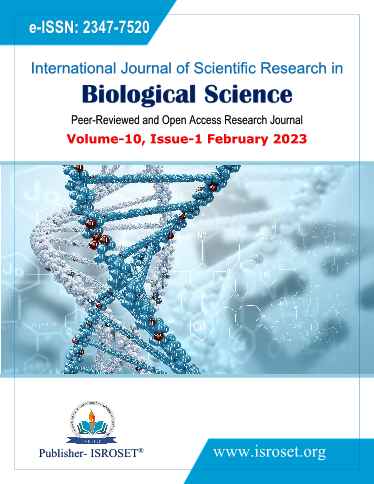Comparing Biocompatibility and Efficacy of Hydroxyapatite Nanocomposites at Nano-level for its Biomedical Application: A Systematic Review
Keywords:
Hydroxyapatite, nanocomposites, biocompatibility, osteogenesis, osteoinduction, bone tissue engineeringAbstract
Aim: To evaluate the biocompatibility and efficacy of various nano-functionalised hydroxyapatite nanocomposites by reviewing several in-vitro studies conducted to test its potential effects on human cell lines and animal cell lines. Methods: A survey of relevant scientific data was done utilizing Pubmed, Ovid Medline, Cochrane Library, Wiley Online Library, Science Direct, Scientific Reports, Grey literature, CINAHL, IOPscience, National library of medicine, Advanced Ceramic Progress, Hindawi, MDPI, JPSR, ACS, Springer, and by using MeSH "Hydroxyapatite nanocomposites and its biocompatibility and efficacy". As stated in Prisma guidelines, in search engines, these words were improved. Results: All four reviewed articles showed positive effects of Hydroxyapatite nanocomposites on their biocompatibility. HA/Au and HA/Pd showed negative results concerning osteoinduction and osteogenesis properties, whereas HA/MAG showed positive results. HA-natural polymers composite showed no cytotoxicity. The bioactive HA/Gr composite coating manifested no cytotoxicity and no antibacterial properties. HA/PCL composite improved cell adhesion and cell proliferation. Statistically, significant improvement in the biocompatibility and efficacy using nano-functionalised hydroxyapatite composites when compared to non-functionalised hydroxyapatite nanocomposites with p< 0.01 Conclusion: From the available scientific sources, Hydroxyapatite nanocomposites are very effective in bone tissue engineering and developing medical-grade prostheses owing to their high biological compatibility and efficiency.
References
Calabrese G, Petralia S, Fabbi C, Forte S, Franco D, Guglielmino S, Esposito E, Cuzzocrea S, Traina F, Conoci S, “Au, Pd and maghemite nanofunctionalized hydroxyapatite scaffolds for bone regeneration,” Regenerative biomaterials, Vol. 7, Issue 5, pp. 461-9, 2020.
Ajayan PM, Tour JM, “Nanotube composites,” Nature, Vol 447, Issue 7148, pp. 1066-8, 2007.
Marinescu C, Sofronia A, Anghel EM, Baies R, Constantin D, Seciu AM, Gingu O, Tanasescu S, “Microstructure, stability and biocompatibility of Hydroxyapatite–titania nanocomposites formed by a two-step sintering process,” Arabian Journal of Chemistry, Vol 12, Issue 6, pp. 857-6, 2019.
Khanal SP, Mahfuz H, Rondinone AJ, Leventouri T, “Improvement of the fracture toughness of Hydroxyapatite (HAp) by incorporating carboxyl functionalised single-walled carbon nanotubes (CfSWCNTs) and nylon,” Materials Science and Engineering: C, Vol 60, pp. 204-10, 2016.
Paul W, Sharma CP, “Porous hydroxyapatite nanoparticles for intestinal delivery of insulin,” Trends Biomater Artif Organs, Vol 14, pp. 37-8, 2001.
Kano S, Yamazaki A, Otsuka R, Ohgaki M, Akao M, Aoki H, “Application of hydroxyapatite-sol as drug carrier,” Bio-medical materials and engineering, Vol 4, Issue 4, pp. 283-90, 1994.
Du C, Cui FZ, Feng QL, Zhu XD, De Groot K, “Tissue response to nano?hydroxyapatite/collagen composite implants in the marrow cavity,” Journal of Biomedical Materials Research: An Official Journal of The Society for Biomaterials, The Japanese Society for Biomaterials, and the Australian Society for Biomaterials, Vol 42, Issue 4, pp. 540-8, 1998.
Yamaguchi I, Tokuchi K, Fukuzaki H, Koyama Y, Takakuda K, Monma H, Tanaka J, “Preparation and microstructure analysis of chitosan/hydroxyapatite nanocomposites,” Journal of Biomedical Materials Research: An Official Journal of The Society for Biomaterials, The Japanese Society for Biomaterials, and The Australian Society for Biomaterials and the Korean Society for Biomaterials, Vol 55, Issue 1, pp. 20-7,2001.
Ferraz MP, Monteiro FJ, Manuel CM, “Hydroxyapatite nanoparticles: a review of preparation methodologies,” Journal of Applied Biomaterials and Biomechanics, Vol 2, Issue 2, pp. 74-80, 2004.
Azizi F, Heidari F, Ghaedi M, “Mechanical Properties and Biocompatibility of Hydroxyapatite/Manganese Dioxide/Palladium Nanocomposite Scaffolds Filled by Natural Chitosan,” Advanced Ceramics Progress, Vol 7, Issue 3, pp. 1-9, 2021.
Jankovi? A, Erakovi? S, Mitri? M, Mati? IZ, Jurani? ZD, Tsui GC, Tang CY, Miškovi?-Stankovi? V, Rhee KY, Park SJ, “Bioactive hydroxyapatite/graphene composite coating and its corrosion stability in simulated body fluid,” Journal of Alloys and Compounds, Vol 624, pp. 148-57, 2015.
Lee HJ, Kim SE, Choi HW, Kim CW, Kim KJ, Lee SC, “The effect of surface-modified nano-hydroxyapatite on biocompatibility of poly (?-caprolactone)/hydroxyapatite nanocomposites,” European Polymer Journal, Vol 43, Issue 5, pp. 1602-8, 2007.
Kikuchi M, Itoh S, Ichinose S, Shinomiya K, Tanaka J, “Self-organization mechanism in a bone-like hydroxyapatite/collagen nanocomposite synthesised in vitro and its biological reaction in vivo,” Biomaterials, Vol 22, Issue 13, pp. 1705-11, 2001.
Itoh S, Kikuchi M, Takakuda K, Koyama Y, Matsumoto HN, Ichinose S, Tanaka J, Kawauchi T, Shinomiya K, “The biocompatibility and osteoconductive activity of a novel hydroxyapatite/collagen composite biomaterial, and its function as a carrier of rhBMP?2,” Journal of Biomedical Materials Research: An Official Journal of The Society for Biomaterials and The Japanese Society for Biomaterials, Vol 54, Issue 3, pp. 445-53, 2001.
Tenhuisen KS, Martin RI, Klimkiewicz M, Brown PW, “Formation and properties of a synthetic bone composite: Hydroxyapatite–collagen,” Journal of biomedical materials research, Vol 29, Issue 7, pp. 803-10, 1995.
Raucci MG, Demitri C, Soriente A, Fasolino I, Sannino A, Ambrosio L, “Gelatin/nano?hydroxyapatite hydrogel scaffold prepared by sol?gel technology as filler to repair bone defects,” Journal of Biomedical Materials Research Part A, Vol 106, Issue 7, pp. 2007-2019, 2018.
Chung JH, Kim YK, Kim KH, Kwon TY, Vaezmomeni SZ, Samiei M, Aghazadeh M, Davaran S, Mahkam M, Asadi G, Akbarzadeh A, “Synthesis, characterisation, biocompatibility of Hydroxyapatite–natural polymers nanocomposites for dentistry applications,” Artificial cells, nanomedicine, and biotechnology, Vol 44, Issue 1, pp.277-84, 2016.
Prashanthy.M.R, DineshDamodhar, Suganya. P, Bharathwaj.V.V, Sindhu.R, Prabhu. D, Shreelakshmi.S, Rajmohan.M, “Low Level Helium-Neon Laser Therapy For Chemoradiotherapy Induced Oral Mucositis In Oral Cancer- A Systematic Review,” Drugs and Cell Therapies in Hematology, Vol 10, Issue 1, pp. 1783-1792, 2021.
Downloads
Published
How to Cite
Issue
Section
License

This work is licensed under a Creative Commons Attribution 4.0 International License.
Authors contributing to this journal agree to publish their articles under the Creative Commons Attribution 4.0 International License, allowing third parties to share their work (copy, distribute, transmit) and to adapt it, under the condition that the authors are given credit and that in the event of reuse or distribution, the terms of this license are made clear.







